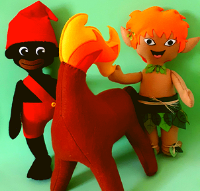
65
em Português
I landed in Manaus, the capital of the state of Amazonas, the heart of the world, the center of the Earth, six hours after departing from Sao Paulo on the first flight—hours locked in the plane. I got off, grabbed my bags, hailed a taxi, and there it was, the first impact: the doors of Eduardo Gomes’ terminal opened, and the heat of the land welcomed me—an unbelievable experience for someone arriving from the southeast. I’ve heard that many people feel sick right there. I like it. This heat will accompany me and my friends throughout our time here.
“Where to? Which hotel are you staying at, sir?”
“Hotel? No hotel at all; straight to the city center!”
The driver doesn’t know it, but I’ll get off along the way. You see, there’s a very typical restaurant on Torquato Tapajós Avenue, right by the roadside, as simple as can be. Guess what? I always do this; it’s the first thing I do every time I come to Manaus: eat fish. Rice, a bit of salad (watch out Paulista for the coriander!), manioc flour, and unlimited fish I already ordered right away: I want Jaraqui (my favorite), but I won’t say no to a good piece of Tambaqui and Pirarucu as well.
With my craving for fish satisfied, or rather, fishes, I will meet with the caboclo Jorge Vasquez; he will take me to meet the Curupira. My heart beats a little faster, somewhat restless, not afraid but excited about the possibilities, and somewhat skeptical too, I confess.
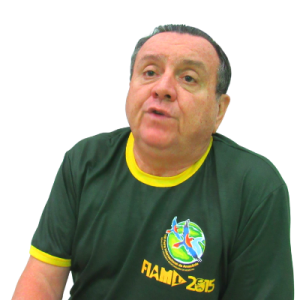
Being with Jorge Vasquez means being close to stories.
“The Curupira is a very ancient legend. When the Portuguese arrived in Brazil, it already existed among the natives. For the indigenous people, the Curupira is a fascinating being: small, covered in hair, with red eyes, blue nails, and feet turned backward. Try to imagine that it’s surreal, but you see, what really matters is that he protects the forest and all the animals that live in it,” Vasquez told me.
I had arranged to meet Vasquez at the Panair market, as the locals call it; the place is very interesting and has an important history for Vasquez and his family. It’s fantastic: a free market, like a covered fair, with lots of vegetables, local fruits, fish, meat, and spices—it’s almost an unpackaged supermarket, a dream for those who practice Zero Waste.
Speaking of fruits, there are thousands of fruits in the Brazilian North: camu-camu, cupuaçu, guaraná, murici, taperebá, tucumã do Amazonas, tucumã do Pará—I don’t know all the names because there are so many, so much richness, incredible exotic flavors, lots of vitamins—a marvel that more people need to know. Creole fruits that carry all the goodness of the forest within them.
After wandering around the market and having another grilled fish, and some Cupuaçu ice cream, we headed towards the boat. In front of us, just behind the market, flowed the majestic Rio Negro. It’s so vast that you can’t see the opposite bank – Manaus is a port city, large ships arrive and depart from Manaus daily, always through the Rio Negro, coming from the sea via the Amazon River.
We boarded the boat and set off. The boat was heading to Novo Airão, but before going up the river, we made a stop on the opposite way, as if we were going to Itacoatiara.
Vasquez planned a quick visit to one of Manaus’ tourist spots and postcard views, and I was grateful. We went to see the spectacle of the Encontro das Águas (Meeting of Waters) – where the Rio Negro, after passing by the center of Manaus and the port, meets the Rio Solimões.
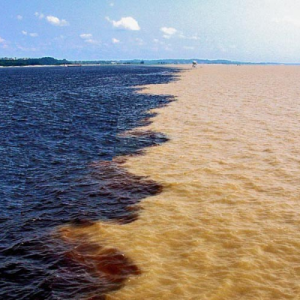
The two rivers meet and then flow side by side for several kilometers without mixing their waters. It’s an incredible sight that anyone visiting the region shouldn’t miss. For us Brazilians, this is where the Amazon River is born – as the Solimões and Negro gradually come together in a peculiar dance, giving birth to the Rio Mar (Sea River), the Amazon River.
As we turned the boat around, passing by the port and the city center once again, I saw the sign “Welcome to Manaus” posted on the riverbank, greeting travelers. The port of Manaus is bustling with activity. People from the surrounding cities come here to buy supplies and sell their products. It’s a beautiful and important place. We passed by Ponta Negra, the famous hotel Tropical, and continued finally upstream for over an hour towards Novo Airão.
Midway, we disembarked at a small village of caboclos (people of mixed indigenous and European descent). There, an indigenous woman named Yuhupdeh, Myiara, led us into the forest. The Yuhupdehs live in the Northwest Amazon and have extensive knowledge of the forest paths. They are skilled hunters and can create poisons from the forest’s herbs.
Myiara already knew the reason for our visit. “Let’s be careful! Even though it’s small, don’t play with it,” Vasquez warned me. “Woe to those who kill or try to hunt small animals or females, or cut down trees, or harm the plants. Curupira protects the forest and all animals!” Myiara cautioned. “I’m starting to like this Curupira more and more,” I thought to myself.
“For us, it doesn’t make sense to gather and accumulate things. Hoarding only leads to spoilage. It’s better to live one day at a time. But for city dwellers, gathering means creating wealth. We don’t understand this kind of wealth; for us, wealth that destroys nature is poverty.”
The Curupira also protects the indigenous people because they are part of nature. When Curupira sees someone doing something wrong – whether it’s an indigenous person or someone from the city – he becomes angry, very furious, and even dangerous. However, Curupira has a good heart. Usually, all he does is chase people, scream, and whistle – horrifying screams – to frighten them and make them run away.
The Curupira has a strong, piercing, and deafening whistle that confuses people’s minds. Myiara continued, “The person runs away out of fear, leaves the place, and stops doing wrong things in the forest, our mother nature. The destruction stops right away. That’s how Curupira protects.”
“Did you notice, Carlos? The Curupira loves life so much that he doesn’t even harm those who hurt him,” Vasquez drew my attention.
“And where is Curupira? I came here to see him,” I said, eager for the encounter.
Myiara responded calmly, “People from the city take longer to realize, that’s why they get lost easily.” She laughed, a joyful and slightly mocking laugh, and added, “The Curupira is here. When we are in harmony with the forest, he is in the air, in the flowers, in the trees, in the animals, in the river, in the streams, in the bath, on the beach, in the macaws flying high above.
Silence your mind, take a deep breath, feel part of the forest. You are part of the forest here and now.”
I tried it… 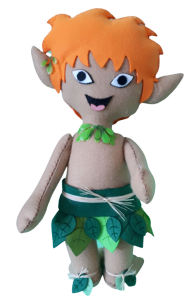 Then I saw the Curupira. Or rather, I felt it. I felt as if something passed by me very quickly, like a breeze, I don’t know, but it felt like someone touched me. I started to smell the pleasant scent of the forest, and then I realized that I was really there. Myiara was right, the Curupira was in everything and everyone.
Then I saw the Curupira. Or rather, I felt it. I felt as if something passed by me very quickly, like a breeze, I don’t know, but it felt like someone touched me. I started to smell the pleasant scent of the forest, and then I realized that I was really there. Myiara was right, the Curupira was in everything and everyone.
The harmony of the forest was the Curupira, and my heart filled with joy as I realized the truth of Nature, the care, and the love for life. I saw the Curupira, and that truth filled my heart.
Composting
I had felt a bit of this before. Composting is wonderful. A few years ago, I decided to set up a compost bin in my apartment. It may sound odd, but it is truly remarkable. I collected three cooking oil buckets with lids from a restaurant and assembled the compost bin. (There are several videos on YouTube showing how to do it.) 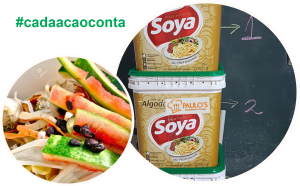 But what’s important is what the composting does to us. We put all the organic waste from the house into it: fruit and vegetable scraps, leaves, eggshells, coffee grounds, tea bags, and more. We also add worms and sawdust or dried leaves to cover the material that will decompose. The worms work their magic, and all of it turns into humus, an excellent fertilizer that we can use for our potted plants or plants around our house. What would have become trash is transformed into a source of life. For a long time, I have been telling my friends that composting is good and enjoyable, but only now, with this encounter with the Curupira, have I realized that my compost bin gives me a taste of the same sensation I felt in the forest. I understand now that, small as it is, it goes takes me into the forest, closer to Mother Nature.
But what’s important is what the composting does to us. We put all the organic waste from the house into it: fruit and vegetable scraps, leaves, eggshells, coffee grounds, tea bags, and more. We also add worms and sawdust or dried leaves to cover the material that will decompose. The worms work their magic, and all of it turns into humus, an excellent fertilizer that we can use for our potted plants or plants around our house. What would have become trash is transformed into a source of life. For a long time, I have been telling my friends that composting is good and enjoyable, but only now, with this encounter with the Curupira, have I realized that my compost bin gives me a taste of the same sensation I felt in the forest. I understand now that, small as it is, it goes takes me into the forest, closer to Mother Nature.
Manauara Friend
Vasco Vasques, son of a Spanish diplomat who arrived in Brazil in Belém do Pará in the 1940s. He was born in the northern region of Brazil and remained in the north all his life. He was the father of my friend Jorge Vasques and two other siblings. Like his father, Jorge Vasques has an overflowing love for the Amazon that can be seen in his eyes. The joy of talking about, showing, and protecting the beautiful things of the Amazon is evident. I was fortunate to meet him the first time I came to Manaus. The Amazon does this to people; it makes you want to talk and belong. Beauty and abundant life are everywhere.
Because of Jorge Vasques, in addition to my business trips, I had the opportunity to go to Manaus two more times to participate in the International Amazon Fair (FIAM) Vasquez was then working at Suframa and was one of the people responsible for the event. At the fair, I saw and, as a journalist, had the opportunity to showcase the strength of Manaus’ industry, especially the Manaus Industrial Pole (PIM). But now, it’s different. Now, during this visit, I came to know the heart of the world, the forest, and its fantastic beings.
The sun seeped through the cracks of the cabin that Myiara managed to arrange for us to spend the night. I finally managed to sleep in the hammock. It’s difficult for those not accustomed to it, but I learned how. This is important because the hammock is the easiest way to accommodate yourself while in the forest, in a cabin.
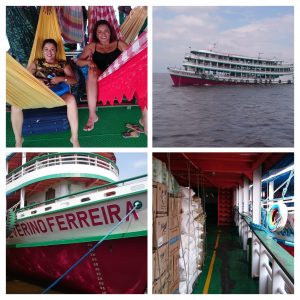 I still remember my first trip from Manaus to Parintins in a large boat, packed with people and cargo. We all traveled lying down, each in our own hammock, but who says I managed to close my eyes? Not at all. I took a few naps during the 18-hour journey, but I spent most of the time awake, swinging in the hammock. It was good because I took many photos and saw a lot.
I still remember my first trip from Manaus to Parintins in a large boat, packed with people and cargo. We all traveled lying down, each in our own hammock, but who says I managed to close my eyes? Not at all. I took a few naps during the 18-hour journey, but I spent most of the time awake, swinging in the hammock. It was good because I took many photos and saw a lot.
Tomorrow we will go to Ariaú Towers, where I will meet Mr. Rita, the hotel owner.
(To be continued…)

 Then I saw the Curupira. Or rather, I felt it. I felt as if something passed by me very quickly, like a breeze, I don’t know, but it felt like someone touched me. I started to smell the pleasant scent of the forest, and then I realized that I was really there. Myiara was right, the Curupira was in everything and everyone.
Then I saw the Curupira. Or rather, I felt it. I felt as if something passed by me very quickly, like a breeze, I don’t know, but it felt like someone touched me. I started to smell the pleasant scent of the forest, and then I realized that I was really there. Myiara was right, the Curupira was in everything and everyone. But what’s important is what the composting does to us. We put all the organic waste from the house into it: fruit and vegetable scraps, leaves, eggshells, coffee grounds, tea bags, and more. We also add worms and sawdust or dried leaves to cover the material that will decompose. The worms work their magic, and all of it turns into humus, an excellent fertilizer that we can use for our potted plants or plants around our house. What would have become trash is transformed into a source of life. For a long time, I have been telling my friends that composting is good and enjoyable, but only now, with this encounter with the Curupira, have I realized that my compost bin gives me a taste of the same sensation I felt in the forest. I understand now that, small as it is, it goes takes me into the forest, closer to Mother Nature.
But what’s important is what the composting does to us. We put all the organic waste from the house into it: fruit and vegetable scraps, leaves, eggshells, coffee grounds, tea bags, and more. We also add worms and sawdust or dried leaves to cover the material that will decompose. The worms work their magic, and all of it turns into humus, an excellent fertilizer that we can use for our potted plants or plants around our house. What would have become trash is transformed into a source of life. For a long time, I have been telling my friends that composting is good and enjoyable, but only now, with this encounter with the Curupira, have I realized that my compost bin gives me a taste of the same sensation I felt in the forest. I understand now that, small as it is, it goes takes me into the forest, closer to Mother Nature.


 I still remember my first trip from Manaus to Parintins in a large boat, packed with people and cargo. We all traveled lying down, each in our own hammock, but who says I managed to close my eyes? Not at all. I took a few naps during the 18-hour journey, but I spent most of the time awake, swinging in the hammock. It was good because I took many photos and saw a lot.
I still remember my first trip from Manaus to Parintins in a large boat, packed with people and cargo. We all traveled lying down, each in our own hammock, but who says I managed to close my eyes? Not at all. I took a few naps during the 18-hour journey, but I spent most of the time awake, swinging in the hammock. It was good because I took many photos and saw a lot.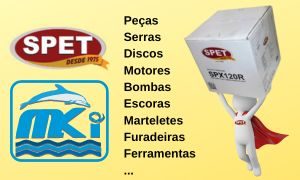





 Facebook
Facebook Youtube
Youtube